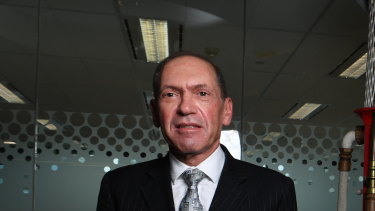Does Caltex’s suitor really want to pay so much for so little?
One of the great curiosities of the $8.6 billion indicative offer by Canada’s Alimentation Couche-Tard is that it is apparently prepared to bid so much to get its hands on so little.
At face value, that’s not an accurate statement. Couche-Tard says it wants the entire company, including Caltex’s fuel and infrastructure businesses.
But the group’s area of expertise is convenience stores, operating more than 16,000 such stores. It has the largest convenience store network in North America and has more recently been expanding into Europe. Caltex would give it a beachhead in Asia Pacific.
Couche-Tard doesn’t however, operate refineries or have a fuels business, even though it buys a lot of fuel.

Caltex’s fuels and infrastructure operations represent more than two-thirds of its value – meaning that to get its hands on the bit that fits with its existing operations, the Canadian group would have to hand over close to $6 billion for the bits that don’t fit.
It’s easy to see why Couche-Tard might like to acquire Caltex’s retail network. It’s the biggest in Australasia, with legal and political frameworks that would be familiar to North America’s. It would provide a secure launching pad for a launch into Asia.
Launching pad
It’s not so easy to see what the Canadians would do with Caltex’s Lytton refinery in Queensland – one of the four remaining refineries in Australia – or the fuels business or Caltex’s expanding international trading operations.
Those questions over the logic of Couche-Tard acquiring and holding the non-retail operations have already raised national interest issues and the potential for Foreign Investment Review Board intervention, given the implications of the closure or sale to a third party of an asset that has implications for national fuel security.
Caltex has rejected Couche-Tard’s “unsolicited, conditional, confidential, non-binding and indicative” proposal, saying the indicative $34.50 a share offer represents a premium of only about 16 per cent to the Caltex share price before the approach was disclosed.
It has, however, indicated a willingness to offer its suitor access to some non-public information, via a management presentation rather than a full due diligence process, if the Canadians agree to sign confidentiality and standstill agreements.
‘In play’
Caltex’s chairman Steven Gregg had a long career in investment banking – he was global head of investment banking for ABN Amro – and would understand that, with Couche-Tard wanting to execute the deal via a scheme of arrangement, he can trade eventual access to a proper due diligence process for a higher price. And, if Couche-Tard proceeds, the board support needed to succeed with schemes of arrangement could be used to elicit another price increase.
The Canadians have a reputation for being disciplined and thus may not be inclined to play that game, in which case they might just walk away.
From Caltex’s perspective, both itself and the Canadians have options.
Caltex is now “in play”, which means it is possible that either Couche-Tard will offer a price the Caltex board can support or another bidder could emerge.
At the other end of the spectrum of possibilities the Canadians might go home, no other bidder might appear and life for Caltex’s management and board would revert to normal. The board could then go ahead with the appointment of a successor to Julian Segal as CEO.
The more interesting option would be to sell Couche-Tard what it presumably most wants – the retail network. That would cost it something around $2 billion rather than $8.6 billion.
That would be a significant strategic decision for Caltex, which has seen a radical revamp of its convenience store offering as a way of diversifying to some extent its exposure to fossil fuels, as well as providing a new growth option.
Its attitude would ultimately, however, revolve around whether the network was worth more to Couche-Tard than to its own shareholders.
Plethora of options
In its international business – at its heart a trading business — Caltex has a plethora of growth options, with its optionality enhanced by its physical infrastructure in Australia and New Zealand and its ability to choose to source either raw or refined product for those markets. Shedding the stores network wouldn’t necessarily compromise its prospects in the near to medium term.
The approach from Couche-Tard has come at an awkward time for Caltex.
It was searching for a new CEO to replace Segal, who plans to retire once his successor had been hired. It is coming off a low point for refining margins. Its relatively new chief financial officer, Matt Halliday, is in the midst of a major restructuring of the group’s balance sheet that will enable Caltex to release, over time, its $800 million or so of franking credits.

There are a number of planks to Halliday’s balance sheet strategy, the foundations for which were the review of the group’s property assets undertaken earlier this year.
Caltex has announced plans to sell 25 of its higher-value retail sites for net proceeds of $92 million; to vend a 49 per cent interest in 250 of its freehold sites into an initial public offering that could release up to $1 billion of capital and a continuation of the review of the rest of its property portfolio to determine their best use.
The company has announced an issue of hybrid securities to raise up to $500 million of what would effectively be cheap equity while the planned IPO is also essentially a way of accessing ultra-cheap funding, with the capitalisation rates sought by property investors a lot less than Caltex’s cost of capital.
The restructuring of the Caltex balance sheet would enable an off-market share buyback in the first half of next year that would release about $400 million of the group’s franking credits, with the rest to flow through more capital management at a later, but not distant, date.
Thus, Caltex has a solid positive story to tell its shareholders if the Couche-Tard offer doesn’t materialise.
It also has a good counter-narrative to use as leverage in negotiations to convince the Canadians that they will have to up the ante if they really want to acquire the entire company – or else fundamentally rethink their strategy and objectives if it’s the convenience store network they really want.
Stephen is one of Australia’s most respected business journalists. He was most recently co-founder and associate editor of the Business Spectator website and an associate editor and senior columnist at The Australian.
Most Viewed in Business
Source: Thanks smh.com